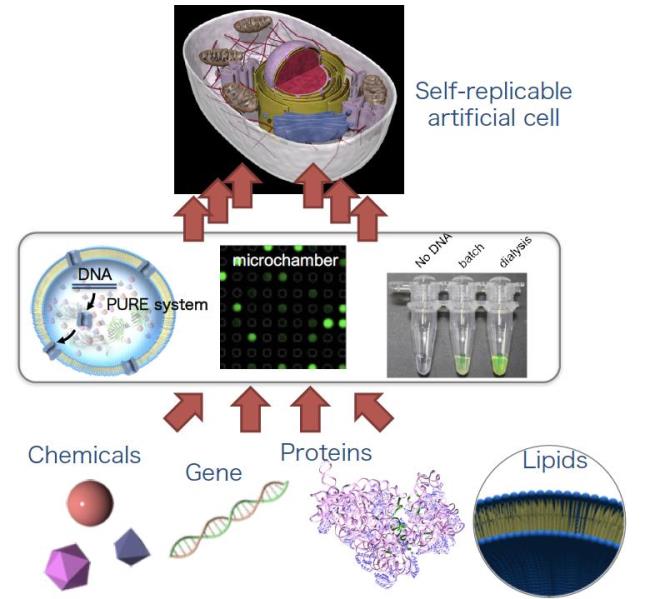Abstract:
It has become possible to construct various biological systems in vitro from elementary components including small molecules (metabolites), proteins, nucleic acids, and phospholipids. The goal of my research is to construct a “living” cell in a bottom-up fashion; i.e., to construct an artificial cell from defined components and to clarify the recipe of life (Figure). Through these processes, we can reveal novel features of biological systems, create valuable molecules and molecular systems, and most importantly, can reveal features of primordial cells and possible scenarios of the origins of life.
The important features of living cells are (1) they have an ability to synthesize protein from DNA (central dogma), (2) protein synthesis occurs inside a micro-compartment, (3) they respond to external chemicals, (4) they have an ability to evolve. We have been working on constructing various molecular systems, which were then assembled to construct an “artificial cell” that satisfy these four properties.
In brief, the artificial cell was constructed by encapsulating reconstituted in vitro transcriptiontranslation system (PURE system) into cell-sized liposome1-3. In this presentation, I will introduce what we have learned by constructing artificial cells4-8, and discuss about how the current artificial cell can be expanded to create autonomously self-replicable cells.
Speaker: Dr. Tomoaki Matsuura, Osaka University
Date: Friday, 14 February, 09:00-10:00 at Mishima Hall (ELSI-1)
Host: Ryuhei Nakamura
It has become possible to construct various biological systems in vitro from elementary components including small molecules (metabolites), proteins, nucleic acids, and phospholipids. The goal of my research is to construct a “living” cell in a bottom-up fashion; i.e., to construct an artificial cell from defined components and to clarify the recipe of life (Figure). Through these processes, we can reveal novel features of biological systems, create valuable molecules and molecular systems, and most importantly, can reveal features of primordial cells and possible scenarios of the origins of life.
The important features of living cells are (1) they have an ability to synthesize protein from DNA (central dogma), (2) protein synthesis occurs inside a micro-compartment, (3) they respond to external chemicals, (4) they have an ability to evolve. We have been working on constructing various molecular systems, which were then assembled to construct an “artificial cell” that satisfy these four properties.
In brief, the artificial cell was constructed by encapsulating reconstituted in vitro transcriptiontranslation system (PURE system) into cell-sized liposome1-3. In this presentation, I will introduce what we have learned by constructing artificial cells4-8, and discuss about how the current artificial cell can be expanded to create autonomously self-replicable cells.
Speaker: Dr. Tomoaki Matsuura, Osaka University
Date: Friday, 14 February, 09:00-10:00 at Mishima Hall (ELSI-1)
Host: Ryuhei Nakamura

